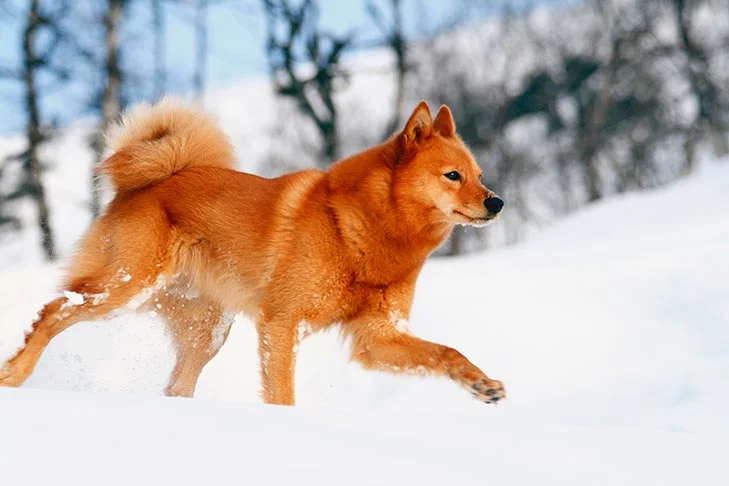The lively Finnish Spitz, a small but fearless hunting dog from the “Land of 60,000 Lakes,” is distinguished by its flame-colored coat, foxy face, and prick ears that project a lively expression, as well as by its curving plumed tail. The Finnish Spitz has been dubbed the “Barking Bird Dog” for its special way of tracking and indicating prey. The Finnish Spitz, often known as a Finkie or a Finn, is a breed of spitz known for its rich, magnificent golden-red coat that is never monochromatic. Finkies make great alert dogs since they are suspicious of strangers but not afraid of them. This is a vocal breed; in Finland, owners compete to name a “King Barker”; true Finn lovers are more amused than offended by the yodeling and variety of vocalization of their breed. Finkies are intelligent, sensitive, and alluring friends who are keen dog athletes and eye-catching show dogs.
Finnish Spitz
good-natured / friendly / lively
Average sizes and life
expectancy of the breed.
Height
17.5-20 inches (male)
15.5-18 inches (female)
Weight
25-33 pounds (male)
20-28 pounds (female)
Life Expectancy
13-15 years
Breed Traits & Characteristics
About the Breed

What To Expect When Caring For a Finnish Spitz
Owning a dog is not just a privilege; it’s a responsibility. They depend on us for, at minimum, food and shelter, and deserve much more. When you take a dog into your life, you need to understand the commitment that dog ownership entails.
 Health
Health
Fortunately, thanks to thoughtful breeding, Finnish Spitz in the U.S. and Canada are generally healthy breeds and don't present many health issues. Responsible breeders screen potential breeding stock for patella, elbows, hips, and eyes, with the numbers of affected dogs very low. New owners are urged to have a conversation with their breeders about care for growing puppies, including the need to limit vigorous exercise and avoid early spay and neutering until maturity (3-5 years) is reached.
 Grooming
Grooming
The Finnish Spitz is a "natural" breed that some owners refer to as "wash and wear." The breed standard is very specific: "No trimming of the coat except for feet is allowed. Whiskers shall not be trimmed. Any alteration of the coat by coloring, dying, trimming, scissoring or other means must be severely faulted." Lightly spraying the coat with water and brushing the coat using a pin brush every two to three days is adequate. Hot blow-drying will dry the outer coat. During their twice-yearly shedding season, daily brushing or a bath followed by a cool-temperature blow-dry and brushing will speed up this process, and a good quality comb and a slicker brush are very useful in getting out the undercoat. The shedding is more severe in an intact female. The coat of a spayed female can become softer and denser and can take more grooming.
 Exercise
Exercise
Finnish Spitz were bred to hunt all day in dense woods, giving them the stamina to range far, making a solidly fenced yard a must. A Finnish Spitz must never be kept away from his people, as he becomes deeply bonded with his family. They require a moderately high degree of exercise. A daily walk, long or short, on a leash is always a reward in and of itself.
 Training
Training
This is a very intelligent breed, and as such they can present a challenge to train. Keep sessions short and fun, being generous with praise and reward. Food seems to be the universal motivator. They'll let you know when they've had enough. Early socialization and puppy training classes are recommended for the new puppy.
 Nutrition
Nutrition
The Finnish Spitz's metabolism is extremely efficient for a primitive breed,' notes one breed expert. This means that overfeeding the breed will result in obesity fairly quickly. High-quality dry dog food works well to maintain good condition and weight. Treats can be useful in training but should be given sparingly. Give table scraps sparingly as well, if at all, especially avoiding cooked bones and foods with high-fat content. Learn about which human foods are safe for dogs, and which are not.
History
The Suomenpystykorva is the most well-liked dog breed in his native Finland. Thankfully, it goes by the name “Finnish Spitz” in English-speaking nations.
It is believed that spitz-type canines were transported by immigrants from central Russia to what is now Finland some 3,000 years ago. These early Finns were used as general-purpose hunters for many years. They eventually started to specialize in gamebirds.
Finkies or Finns have a distinctive approach to bird-dogging. Their keen nose guides them to birds in trees. Then, they captivate the bird with their trademark “yodeling,” or rapid-fire barking (they can produce 160 barks per minute), and slow tail-wagging. The hunter can see the dog through the dark forest because of the dog’s swishing tail, which also serves another purpose. This stops play until a human with a rifle shows up to do the job. Birds are flushed and led to the trees by finkies as well.
These hardy Norsemen threatened extinction by the late 1800s. Hugo Roos and Hugo Sandberg, two devoted Finkie fans from Finland, organized a marketing campaign that helped save the species from extinction. By the end of the century, the Finnish Spitz was known.



